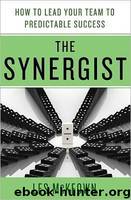The Synergist: How to Lead Your Team to Predictable Success by McKeown Les

Author:McKeown, Les [McKeown, Les]
Language: eng
Format: mobi
Tags: Business
ISBN: 9780230120556
Publisher: Palgrave macmillan
Published: 2012-01-03T00:00:00+00:00
HOW FORMAL MEETINGS GRIDLOCK
Once the V-O-P team has met on a number of occasions, three things become apparent.
1. There is no V-O-P “team,” just individuals in a group setting.
Successful teams operate like a group of crack surgeons performing a complex operation—they gather around an issue, dissect it, hold it up to the light, swap information and opinion, all the while searching for the best solution for the enterprise or organization. The V-O-P team doesn’t do this. In fact, the Visionary, Operator, and Processor don’t operate as a team at all, but as individuals in a group environment—a very different thing.
Because of the fundamental differences in how they behave in meetings, their natural tendency with any issue is to pass it from one to the other and back again, each doing their V, O, or P thing in turn, with little or no genuine pooling of knowledge, experience, or skill.
2. The group is rarely, if at all, in “the zone.”
This is a state best described by Mihaly Csikszentmihalyi in his book Flow: The Psychology of Optimal Experience. Csikszentmihalyi describes a place reached by individuals when they are in a state of peak performance—everything is moving along smoothly and we’re knocking down our goals one by one. We’re enjoying what we are doing, having fun and being productive at the same time.
Teams can reach this same state of flow, and when they do, they accomplish their goals with (relative) ease, without tension or stress, and with disagreement expressed in a positive, supportive way (more about this in Part III).
Because the Visionary, Operator, and Processor have incompatible goals and motivations, and act so differently in meetings, the V-O-P team rarely, if ever, reaches this stage of flow. Instead, the opposite of flow happens. As the spotlight moves from Visionary to Operator, Operator to Processor, and back again, the discussion and interaction are staccato and brittle. Tensions grow, leading to increasingly frequent curt and unproductive disagreements. Little of value is achieved and everyone leaves the meeting tired and unfulfilled.
3. Trust is undermined.
Turning up for a meeting and leaving some time later feeling frustrated and dissatisfied happens to all of us once in a while. For the V-O-P team, after it happens two or three times, that frustration rapidly turns into mistrust. Why? Well, once it becomes clear that no matter how often they meet, they can’t produce anything of value, it’s natural to look for a common thread, to try to identify an underlying reason for the team’s dysfunction. And (as we all do) the Visionary, Operator, and Processor each start by assuming the other is at fault: “How could she go on and on about that crackpot idea of hers when it was obvious that the rest of us weren’t buying it?” “Why doesn’t he just get his diary out, write down the date of our meetings, then turn up?” “If I have to listen to another 35-page presentation on why our receivables are up by 0.2 days, I’ll shoot myself.”
No one likes to have their time wasted by others, certainly not willfully and repeatedly.
Download
This site does not store any files on its server. We only index and link to content provided by other sites. Please contact the content providers to delete copyright contents if any and email us, we'll remove relevant links or contents immediately.
Hit Refresh by Satya Nadella(8460)
The Compound Effect by Darren Hardy(7836)
Change Your Questions, Change Your Life by Marilee Adams(6812)
Nudge - Improving Decisions about Health, Wealth, and Happiness by Thaler Sunstein(6785)
The Black Swan by Nassim Nicholas Taleb(6369)
Daring Greatly by Brene Brown(5824)
Deep Work by Cal Newport(5823)
Principles: Life and Work by Ray Dalio(5501)
Rich Dad Poor Dad by Robert T. Kiyosaki(5384)
Man-made Catastrophes and Risk Information Concealment by Dmitry Chernov & Didier Sornette(4956)
Big Magic: Creative Living Beyond Fear by Elizabeth Gilbert(4899)
The Myth of the Strong Leader by Archie Brown(4890)
The Slight Edge by Jeff Olson(4843)
Digital Minimalism by Cal Newport;(4806)
Discipline Equals Freedom by Jocko Willink(4761)
The Motivation Myth by Jeff Haden(4660)
Stone's Rules by Roger Stone(4543)
Management Strategies for the Cloud Revolution: How Cloud Computing Is Transforming Business and Why You Can't Afford to Be Left Behind by Charles Babcock(4220)
Factfulness: Ten Reasons We're Wrong About the World – and Why Things Are Better Than You Think by Hans Rosling(4160)
